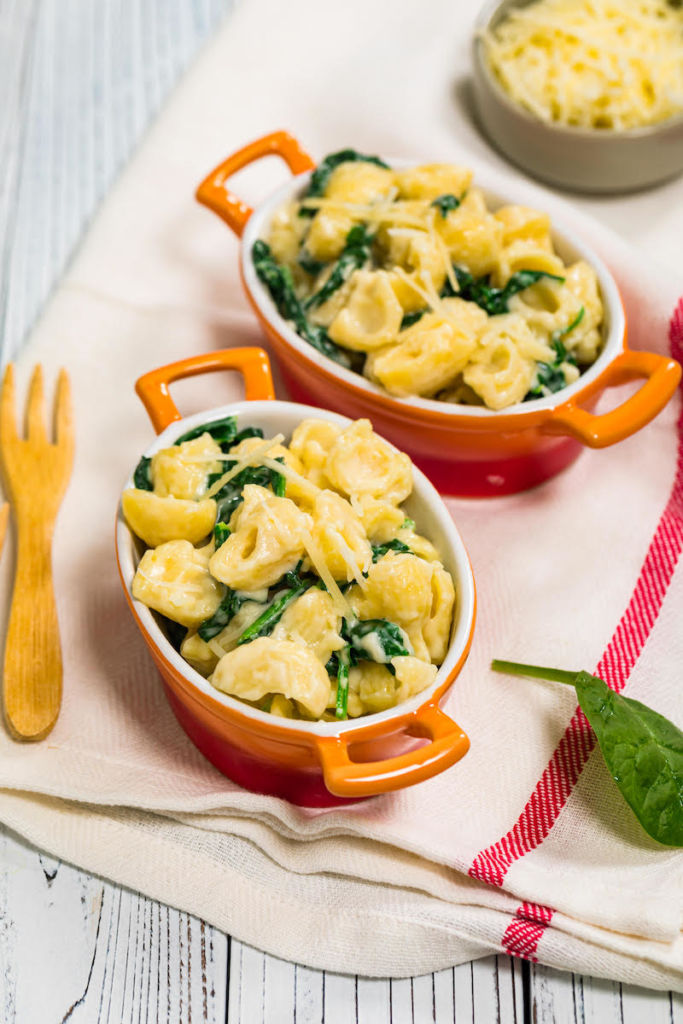Did someone say healthier mac and cheese? Yes, please! Our Cauliflower and Squash Mac and Cheese recipe is so creamy and delicious no one will ever guess it is made from good-for-you ingredients. All you need is two pots and 30 minutes to create a satisfying dish full of cozy flavors. The comforting mac and cheese is all about maximizing taste and minimizing cleanup—not to mention a great way to get your kids to eat their vegetables. It can also meet the majority of dietary needs with gluten-free and vegan options. This reinvented classic blends earthy cauliflower and nutty butternut squash to replace the heavy cream but maintains a familiarly delicious rich and velvety texture along with a boost of gut-supporting fiber. In my household, it’s become a winter weekend staple.
Cauliflower and Squash Mac and Cheese
Servings: 4
Ingredients
- 1 12 oz box of pasta (macaroni noodles or shells)
- 1 tbsp oil
- 2 large handfuls of spinach (optional)
Sauce
- 1 small cauliflower (8-12 oz) or 12 oz bag of frozen cauliflower*, use the florets of the cauliflower
- You can save the stem to roast for another recipe.
- 1 1/2 cups butternut squash (fresh or frozen)*, peeled and cut int 1 inch dice (you can also use leftover roasted butternut squash)
- 2 teaspoons oil
- 1/2 cup dairy or nondairy milk
- 1/2 tsp garlic powder
- ½ a lemon juiced
- 1/2 cup nutritional yeast
- ½-1 cup shredded cheddar cheese (optional)
- If not using cheese add additional ¼ cup nutritional yeast
- 1/2 tsp salt
- Pinch of black pepper and cayenne pepper or paprika
Garnish with fresh herbs (parsley or basil or chives)
*It works best to use both fresh cauliflower with fresh butternut squash, or frozen cauliflower with frozen butternut squash. This allows for them to be cooked together for the same amount of time.
Directions
- Heat 2 large pots of salted water to a boil. Cook pasta in one pot for the time indicated on the package.
- Cook cauliflower and squash in the other pot of boiling water. If fresh, cook for ~15-20 minutes until extremely tender. Test a piece of cauliflower and squash, if both can easily be smashed with a fork with no resistance then they are done. If using frozen cooking time will be less (~7 min) but still do the same test for doneness.
- Drain pasta when cooked. Place pasta in a large bowl and mix with oil and spinach allowing spinach to wilt and ensure pasta does not stick.
- Drain vegetables and place in a food processor with remaining sauce ingredients and blend until very smooth. If too thick you can add a little more milk to thin it and help it blend.
- Taste and adjust seasoning or add more nutritional yeast for your flavor preference.
- Start by adding ½ of sauce to pasta and gently mix. Add more of the sauce to reach the desired sauce to pasta ratio. I usually use ¾ of the sauce and use the remaining for roasted vegetables. The remaining sauce will keep in the refrigerator for up to 5 days.
This dish also tastes great mixed with sautéed mushrooms or placed in a greased baking dish, topped with a sprinkle of parmesan and breadcrumbs and baked in a 450 degree oven for 10 minutes to crisp up the top.
Nutrient Highlights
Cauliflower: A member of the Cruciferous family of vegetables, cauliflower provides a good source of dietary fiber, thiamin, riboflavin, pantothenic acid, niacin, Vitamin B-6, Vitamin C, and Vitamin K. Cauliflower is also rich in anti-inflammatory properties from phytochemicals (carotenoids, polyphenols, flavonoids, and ascorbic acid), and gut health promoting properties, due to it being a prebiotic (food for our good gut bacteria). This is one of the most nutrient-dense foods, with only 25 calories per cup, and packed full of immune and health supporting vitamins and minerals.
Butternut Squash: Helps keep our eyes and skin healthy due to high amounts of carotenoids that have also been shown to help prevent the development of certain cancers. It is also packed full of fiber to help prevent constipation. It contains essential antioxidants to neutralize free radicals and boost your immune system.
Lemon juice: Lemons are a versatile fruit that can be added to savory or sweet dishes. This little fruit packs a lot of bang for its buck, since it contains fiber; various beneficial plant compounds, and up to 51% of your Vitamin C needs. Lemons contain a soluble fiber called pectin, which has been found to make you feel fuller longer and improve gut health. This fruit may also help to prevent the formation of kidney stones by increasing urine volume and the pH, making it difficult for kidney stones to form.
Garlic and Shallot: These vegetables are powerful prebiotics, meaning they feed the “good” bacteria in our gut and promote a healthy digestive system. Research supports that compounds such as allicin in garlic and shallots have antioxidant, anti-inflammatory, antimicrobial, and cardio-protective properties.
Nutritional Yeast: A tasty and nutritious substitute for cheese. It is a complete protein, containing all 9 essential amino acids. It is also packed full of B vitamins. It can help prevent B-12 deficiency in vegans and is high in glutathione and selenomethionine, antioxidants that can help protect the body from oxidative stress.



 Ananda Kaplan
Ananda Kaplan


